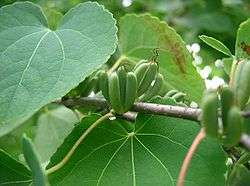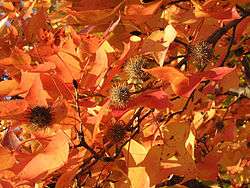Definify.com
Definition 2025
楓
楓
Translingual
Han character
楓 (radical 75 木+9, 13 strokes, cangjie input 木竹弓戈 (DHNI), four-corner 47910, composition ⿰木風)
References
- KangXi: page 539, character 8
- Dai Kanwa Jiten: character 15126
- Dae Jaweon: page 926, character 21
- Hanyu Da Zidian: volume 2, page 1253, character 8
- Unihan data for U+6953
Chinese
| trad. | 楓 | |
|---|---|---|
| simp. | 枫 | |
Glyph origin
| Characters in the same phonetic series (凡) (Zhengzhang, 2003) | |
|---|---|
| Old Chinese | |
| 嵐 | *b·ruːm |
| 葻 | *b·uːm |
| 釩 | *pʰomʔ |
| 汎 | *pʰoms, *bum |
| 凡 | *bom |
| 帆 | *bom, *boms |
| 颿 | *bom, *boms |
| 軓 | *bomʔ |
| 梵 | *bloms, *bum |
| 芃 | *boːŋ, *bum |
| 風 | *plum, *plums |
| 飌 | *plum |
| 楓 | *plum |
| 猦 | *plum |
| 偑 | *plum |
| 檒 | *plum |
| 瘋 | *plum |
| 諷 | *plums |
| 堸 | *blum |
| 渢 | *blum |
| 鳳 | *bums |
Pronunciation
- Mandarin
- Cantonese (Jyutping): fung1
- Hakka (Sixian, PFS): pûng
- Min Nan (POJ): png
- Wu (Wiktionary): fon (T1)
- Mandarin
- (Standard Chinese, Beijing)+
- Pinyin:
- Zhuyin: ㄈㄥ
- Wade-Giles: fêng1
- Gwoyeu Romatzyh: feng
- IPA (key): /fɤŋ⁵⁵/
- (Standard Chinese, Beijing)+
- Cantonese
- (Standard Cantonese, Guangzhou)+
- Jyutping: fung1
- Yale: fūng
- Cantonese Pinyin: fung1
- IPA (key): /fʊŋ⁵⁵/
- (Standard Cantonese, Guangzhou)+
- Hakka
- (Sixian, incl. Miaoli and Meinong)
- Pha̍k-fa-sṳ: pûng
- Hakka Romanization System: bung´
- Hagfa Pinyim: bung1
- IPA: /puŋ²⁴/
- (Sixian, incl. Miaoli and Meinong)
- Min Nan
- (Hokkien)
- Pe̍h-ōe-jī: png
- Tâi-lô: png
- Phofsit Daibuun: pngf
- IPA (Xiamen): /pŋ̍⁴⁴/
- IPA (Quanzhou): /pŋ̍³³/
- IPA (Zhangzhou): /pŋ̍⁴⁴/
- IPA (Taipei): /pŋ̍⁴⁴/
- IPA (Kaohsiung): /pŋ̍⁴⁴/
- (Hokkien)
- Wu
- (Shanghainese)
- Wiktionary: fon (T1)
- IPA (key): /fʊŋ⁵³/
- (Shanghainese)
| Rime | |
|---|---|
| Character | 楓 |
| Reading # | 1/1 |
| Initial (聲) | 幫 (1) |
| Final (韻) | 東 (2) |
| Tone (調) | Level (Ø) |
| Openness (開合) | Open |
| Division (等) | III |
| Fanqie | 方戎切 |
| Reconstructions | |
| Zhengzhang Shangfang |
/pɨuŋ/ |
| Pan Wuyun |
/piuŋ/ |
| Shao Rongfen |
/piuŋ/ |
| Edwin Pulleyblank |
/puwŋ/ |
| Li Rong |
/piuŋ/ |
| Wang Li |
/pĭuŋ/ |
| Bernard Karlgren |
/pi̯uŋ/ |
| Expected Mandarin Reflex |
fēng |
| Zhengzhang system (2003) | |
|---|---|
| Character | 楓 |
| Reading # | 1/1 |
| No. | 2923 |
| Phonetic component |
凡 |
| Rime group |
侵 |
| Rime subdivision |
3 |
| Corresponding MC rime |
風 |
| Old Chinese |
/*plum/ |
Definitions
楓
Compounds
|
Japanese
Kanji
(“Jinmeiyō” kanji used for names)
Readings
Compounds
|
Kun'yomi:
On'yomi:
|
Etymology 1
| Kanji in this term |
|---|
| 楓 |
|
かえで Jinmeiyō |
| kun'yomi |
Originally a compound of 蛙 (kaeru, “frog”) + 手 (te, “hand”), with the te changing to de due to rendaku (連濁), and the ru dropping out over time. From the way the palmate leaves resemble a frog's foot.[1][2]
Pronunciation
Alternative forms
Noun
楓 (hiragana かえで, romaji kaede, historical hiragana かへで)
- the maple tree
- a color scheme for 襲 (kasane, “layered kimono”, literally “layering”), where both the outer and inner layers are light green
- a kind of 家紋 (kamon, “family crest”), featuring a maple-leaf design
- (term of endearment) a child's hand (from the resemblance in shape between a hand with splayed fingers and a maple leaf)
Usage notes
As with many terms that name organisms, this term is often spelled in katakana in biological contexts, as カエデ.
Derived terms
|
Proper noun
楓 (hiragana かえで, romaji Kaede)
- A female given name.
Etymology 2
| Kanji in this term |
|---|
| 楓 |
|
かいで Jinmeiyō |
| kun'yomi |
Shift in pronunciation of kaede.[1]
Pronunciation
Noun
楓 (hiragana かいで, romaji kaide)
- (uncommon) alternate reading for kaede: the maple tree
Etymology 3

| Kanji in this term |
|---|
| 楓 |
|
かつら Jinmeiyō |
| kun'yomi |
From Old Japanese. Less common spelling for 桂 (katsura).[1]
Pronunciation
Noun
楓 (hiragana かつら, romaji katsura)
- 桂: the katsura tree, Cercidiphyllum japonicum
- 桂: (Chinese mythology) the kind of tree that grows on the moon
Usage notes
As with many terms that name organisms, this term is often spelled in katakana in biological contexts, as カツラ.
The katsura reading is rare for this kanji. When referring to the katsura tree, the 桂 spelling is used more often to avoid confusion.
Etymology 4
| Kanji in this term |
|---|
| 楓 |
|
おかつら Jinmeiyō |
| kun'yomi |
From Old Japanese. Alternate spelling for 男桂 (okatsura, “male katsura”), an archaic name for the katsura tree.[1] Compare 女桂 (mekatsura, “female katsura: the cinnamon tree”). Appears with this reading in the 和名類聚抄 (Wamyō Ruijushō), a Japanese dictionary of Chinese characters completed in 938.
Pronunciation
Noun
楓 (hiragana おかつら, romaji okatsura, historical hiragana をかつら) (alternative reading hiragana おかづら, romaji okazura)
- (obsolete) the katsura tree, Cercidiphyllum japonicum
Etymology 5

| Kanji in this term |
|---|
| 楓 |
|
ふう Jinmeiyō |
| on'yomi |
From Middle Chinese 楓 (biung).
Pronunciation
Noun
Usage notes
As with many terms that name organisms, this term is often spelled in katakana in biological contexts, as フウ.
Idioms
|
References
- 1 2 3 4 1988, 国語大辞典(新装版) (Kokugo Dai Jiten, Revised Edition) (in Japanese), Tōkyō: Shogakukan
- 1 2 3 4 2006, 大辞林 (Daijirin), Third Edition (in Japanese), Tōkyō: Sanseidō, ISBN 4-385-13905-9
Korean
Hanja
楓 • (pung) (hangeul 풍, revised pung, McCune-Reischauer p'ung, Yale phung)
- This term needs a translation to English. Please help out and add a translation, then remove the text
{{rfdef}}.
Vietnamese
Han character
楓 (phong)
- This term needs a translation to English. Please help out and add a translation, then remove the text
{{rfdef}}.